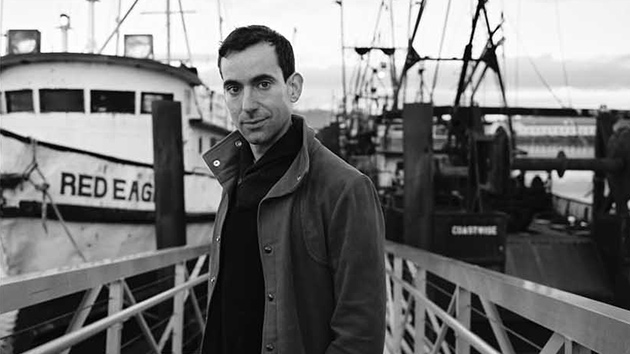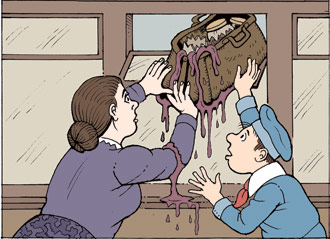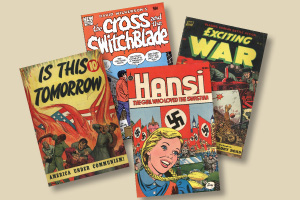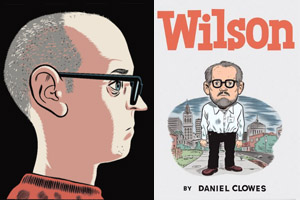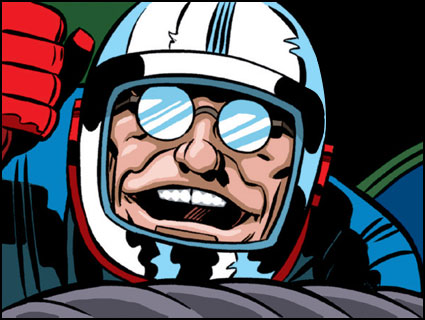
Comic artwork by <a href="http://www.bpib.com/illustra2/kirby.htm">Jack Kirby</a> and <a href="http://www.joesinnott.com/">Joe Sinnott</a>
Click here for a slideshow of selections from The Someday Funnies.
Listen to an audio version of this interview:
The cultural gems unearthed for The Someday Funnies: A Comic History of the 1960s, out this week from Abrams ComicArts, were first commissioned by Rolling Stone back in the early ’70s but are only now making it into print. Which is kind of amazing, given the iconic artists and writers involved: Federico Fellini, Tom Wolfe, William S. Burroughs, Pete Townshend, Frank Zappa, Stan Mack, Will Eisner, and Jack Kirby, to name just a few. The book never would have been published at all had it not been for the heroic efforts of its original editor and mastermind Michel Choquette. On the eve of publication, I caught up with Choquette to talk about his days at National Lampoon, Salvador Dalí’s penis-shaped pool, and going belly-up in pursuit of his dream.
Mother Jones: Virginia Woolf’s husband, Leonard, once said that a man should change his career every seven years. Your life seems to be an effort to exceed that level of mutability. By your mid-20s you’d been a moviemaker, a student of Mesopotamian languages, a professional photographer, a musician, and a protégé of the musical satirist Tom Lehrer. How did you do it all?
Michel Choquette: I never thought about it. Whatever happened happened; that kind of thing. And it wasn’t quite as sequential as you make it sound. They often overlapped.
MJ: Sometime after that you toured the country as part of the Time Square Two, a comedy act that exposed you to a national audience on, among other things, The Merv Griffin Show. What are you fondest memories of that time?
MC: I think it was creating the material. And performing it too, of course; but we were mainly a television act because we were very visual. Sort of re-creating in a surrealized way the days of vaudeville. But I think performing in clubs where you had a very direct relationship with the audience and where you could start ad-libbing material that you would later incorporate into the act, I think those were probably my favorite moments.
MJ: Sometime after that you got a job as an editor at the National Lampoon. They ran a photo story called “Stranger in Paradise,” which you created by shooting a 70-year-old Hitler impersonator for two weeks in Martinique, including a shot of him nude sunbathing. How did you pull that off?
MC: Well. I’d heard about this guy through a filmmaker friend of mine. He was an ex-acrobat who had been part of a Swiss acrobat family team. He had discovered at one point that he had a bone structure that with a little mustache could turn him into Hitler. He’d had a few minor little roles and then a fairly good part in René Clément’s film Is Paris Burning? That was his claim to fame, and he’d sent press clippings to absolutely everyone, including my friend. And when I saw that photograph, it occurred to me that something that would contrast his crisp German uniform with something like a soft background of palm trees and lapping waves would probably be the best. It’s featured quite well in another book that Abrams just put out by Rick Meyerowitz, called Drunk Stoned Brilliant Dead, about the years that all of us were doing the Lampoon. The nude shot is about 16 inches wide, a full spread in that book.
MJ: National Lampoon is a cultural icon now. What was it like then?
MC: We were having a lot of fun. We knew we were breaking new ground in the sense that we weren’t just scraping money together to put out little magazines of our own on small presses like the underground guys were doing. We had Madison Avenue behind us. Of course we had to be a little more careful; a little more self-censored perhaps. But still, we were doing things that had not been possible before.
MJ: You edited a comic piece there called “College Concert Cut-Ups.”
MC: Jann Wenner, the publisher of Rolling Stone, had seen “College Concert Cut-Ups.” We also did a parody of Rolling Stone called “Rolling Stein” set in 1791, that I did with Anne Beatts. I think those were the pieces that Wenner saw.
 Detail from “Clever Ruse Comix;” writer: Chris Miller; art: Gray MorrowMJ: So he asked you to put together a collection of comics in the form of a history of the ’60s.
Detail from “Clever Ruse Comix;” writer: Chris Miller; art: Gray MorrowMJ: So he asked you to put together a collection of comics in the form of a history of the ’60s.
MC: At the time it wasn’t envisaged as a book. Jann wanted me to put a 20-page supplement together for Rolling Stone—a loose history of a few thoughts about the ’60s, about the music scene and the politics. And as I started to go and round up artists, I started realizing that there was a possibility of a book here. Jann did get interested in that for his book publishing company Straight Arrow, but eventually, he decided to back out of both the supplement and the book. I was left holding the bag with a lot of promises to a lot of artists, and that’s when I decided to carry on no matter what and find a publisher somehow.
MJ: Do you think you and Wenner were envisioning the same project?
MC: Yeah, I think so, at the beginning. Certainly I started to be more interested in European things, so we probably had a slightly different vision of it. I don’t think it was by any means one that we couldn’t have come to terms with in the selection process. I never quite knew why he backed out: financial concerns, who knows? We parted amicably and he relinquished all the rights and I just carried on by myself.
MJ: Talk to us about how the project developed, and please don’t skimp on the celebrity name-dropping: I mean, Jean-Paul Sartre, Joni Mitchell, Abbie Hoffman, Charlie Watts, Norman Mailer…
MC: Only like 15 percent or 20 percent of all those people I went to see delivered in the end. But I did go and see a lot of people—all the people who were doing North American traditional comics and all the underground people and then many people who don’t normally do comics, like Joni Mitchell and Frank Zappa. Or people who’d done them at one point in their lives, like Federico Fellini. Some of them said yes and didn’t deliver, and some of them said yes and did. Most of them said, “Well let me think about it.” In the book’s preface I run a little timeline which mentions all the people that I did write to or actually get to see, with the ones who were actually in the book in boldface.
MJ: Who’s the person you most regret not being able to get?
MC: I don’t have one person, but it would’ve been kind of nice to get Dalí to do something. I even proposed to him that he do a blank page. And then he said, “Yeah, that’s a good idea,” and then a few minutes later, he told his wife that we’d had this idea, and later he told this other guy who was with us in Spain that it was his idea. But that didn’t bother me. If he’d done that and signed it, I suppose I would’ve run it. Then he wanted to do a poster for the book. He asked me if I was rich because he told me he wasn’t very interested in the poor, and I said, no I wasn’t rich. And he asked me if my publishers were, and I said, well, they might be able to do something like a poster if you wanted. I always hoped, and perhaps this is why I wish I had Dalí in the book, I always hoped I could’ve come back to Dalí and—let’s say Dalí wanted $25,000 to do the poster—I could’ve said, “Well, here’s 12,500 bucks. Do half a poster.” But I never had that opportunity! I enjoyed very much meeting him, and I definitely had fun sitting with him around his penis-shaped pool.
 Detail from “The Commune,” text & art by Randall EnosMJ: After Wenner dropped out, how did you go about this?
Detail from “The Commune,” text & art by Randall EnosMJ: After Wenner dropped out, how did you go about this?
MC: I went to see a lot of publishers in New York. Harper and Row is the one who bit, in the fall of 1972. I think I was actually only two months without a publisher. And Cass Canfield Jr., who was running the editorial department at Harper and Row, was very keen on the book and that gave it a new impetus and enough of an advance so I could go back to Europe and collect the work from the people who’d promised it to me, find new people, and also travel around the States. I produced a dummy of the book, and Cass was very happy with the dummy, but his marketing people in the end backed out. They just couldn’t quite understand what to do with book and how to market it. There was such an eclectic combination. It wasn’t really like Marvel Comics people, it wasn’t really like all underground—it was a mixture. So I was left with no publisher. After that I tried to raise private money to put out the book myself, and I came very close. But in the end, it didn’t happen. That took up another three or four years, making a total of about seven years I’d been working on the book. At which point I just had to move on and just put everything away safely and hope that something would happen someday.
MJ: You sort of disappeared from view and then reappeared decades later in a 2009 profile in Comics Journal. What were some of your high points during that hibernation?
MC: Well, one of the low points was that I declared bankruptcy because I had spent so much money on the book. The advances were just a drop in the bucket compared to what I spent, borrowed, and earned wherever I could to put into the book. So I just lay very low for awhile and I became not even a barman, but a barboy in a bar in Montreal. I pulled out of that and started making films at the National Film Board. I directed and wrote films—animation and live action. I ended up being asked by McGill University in Montreal to teach screenwriting, and then by Concordia University in Montreal, and I’ve been teaching screenwriting and creative writing for years now. I’ve been doing the odd project, one little film here and there, reviving some of my old songs and recordings. I got involved for a while in the shmatte business, because my girlfriend is a fashion designer. After Bob Levin’s article on me appeared in the Comics Journal, Charlie Kochman at Abrams decided he wanted to publish the book. There was a lot of work left to do, even though I had the actual original art: all the strips had to be colored and all that kind of stuff, contacting everybody to renew my old agreement with them, or their heirs. I had to employ a crew of nine people to get the book done.
MJ: What was the reaction of the artists when you contacted them after all this time? Did anyone want to pull out of the project?
MC: No. I had a couple who gave me a hard time, but everybody else, it’s, “You hung on for so long. Congratulations! What perseverance!” I’m getting that from everywhere. I was afraid there was gonna be a whole Pandora’s box of angry contributors, and I was ready to face it. But I can’t tell you the cooperation and enthusiasm I’ve gotten. A few of the artists were concerned that, “My stuff doesn’t look like that anymore. I’ve improved so much. I’m a little worried. Let me see a scan of the artwork.” And I had to persuade a few of them, “No, no. This is a time capsule. You can’t change what it was.” They all came around in the end, thank God.
MJ: I spoke with Randall Enos, one of the contributors, who’s been a contributor to Mother Jones, and he was thrilled by the whole thing. But he said, “I honestly could not remember doing the strip and until they showed it to me; I couldn’t remember what it was like.”
MC: And then he said, “Hey, not bad!” I remember that, actually. We had quite a bit of that: People who literally even swore, “I never did such a piece.” On the other hand, I called Russ Heath, and he’s getting on a bit, and I gave him my usual pitch, “Well, you may not remember this but years ago, you did a strip for me.” And he cut me off right away. He said, “Yeah, I think I spelled something wrong on that guy’s helmet.” [Laughs.] He was right.”
 Detail from an untitled comic, text & art by Louise SimonsonMJ: One thing that’s interesting to me is the women cartoonists and writers in your collection. You’ve got some stellar people, including Trina Robbins, who’s done influential work and founded the Wimmen’s Comix series. To my eye, there’s a distinct difference between what the women and the guys in The Someday Funnies are seeing as liberation at this time in history. Any thoughts?
Detail from an untitled comic, text & art by Louise SimonsonMJ: One thing that’s interesting to me is the women cartoonists and writers in your collection. You’ve got some stellar people, including Trina Robbins, who’s done influential work and founded the Wimmen’s Comix series. To my eye, there’s a distinct difference between what the women and the guys in The Someday Funnies are seeing as liberation at this time in history. Any thoughts?
MC: I never really thought about it, but I guess you’re right. In fact I know that Louise Simonson said about her contribution, “Oh, I wonder whether I was saying the right thing,” until she saw the strip. And then she said, “Oh, it’s alright. I didn’t draw too well then. But, you know, I like the strip.” So, there you are.
MJ: So what’s your next career change going to be?
MC: [Laughs.] Well, I’m booked for teaching next year, starting right after Labor Day, so I’m not sure. I think I will probably do a documentary film on my father, who was a very well-known writer and poet in Canada. But mostly he is the one who started dramatic radio in the 1930s and he wrote, believe it or not, 6,500 scripts for radio and produced them himself—plus about 300 for television—so his life is a kind of a look back at what the beginnings of media were here in French Canada, in Quebec.
MJ: I did notice in Levin’s piece that both of your parents set fairly high standards for you in terms of their accomplishments.
MC: They let me do what I wanted to do. They encouraged me. Put it that way.
Click here for a slideshow of selections from The Someday Funnies.
